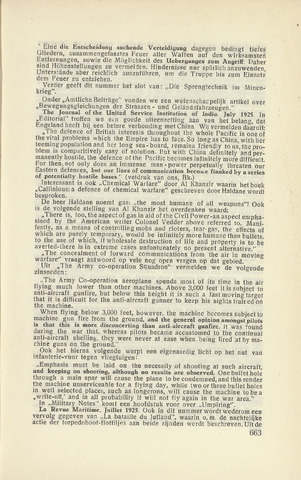663
Eine die Entscheidung suchende Verteidigung dagegeil bedingt tiefeS
Gliedern, zusammengefaszfes Feuer aller Waffen aut den wirksamsten
Entfernungen, sowie die Müglichkeit des Ueberganges zum AngrifF. Daher
sind Höhenstellungen zu vermeiden, Hindernisse nur sparlich anzuwenden
Unterstande aber reichlich auszuführen, um die Truppe bis zum Einsatz
dem Feuer zu entziehen.
Verder geeft dit nummer het slot van: „Die Sprengtechnik im Minen-
krieg
Onder „Amtliche Beitrage" vonden we een wetenschappelijk artikel over
„Bewegungsgleichungen der Straszen - und Gelandefahrzeugen."
The Journal of the United Service Institution of India. July 1925. In
„Editorial" troffen we e<.n goede uiteenzetting aan van het belang, dat
Engeland heeft bij een betere verhouding met China Wij vermelden daaruit-
„The defence of British interests throughout the whole Pacific is one of
the vital problems which the Empire has to face. So long as China with her
teeming population and her long sea-board, remains friendly to us the pro
blem is comparitively easy of solution. But with China definitely and per
manently hostile, the defence of the Pacific becomes infinitely more difficult.
For then, not only does an immense man-power perpetually threaten our
Eastern defences, but our lines of communication become flanked by a series
of potentially hostile bases (vetdruk van ons, Bk.)
Interessant is ook „Chemical Warfare" door Al Khanzir waarin het boek
„Callinious:a defence of chemical warfare" geschreven door Haldane wordt
besproken.
De heer Haldane noemt gas: ,.the most humane of all weapons"! Ook
is de volgende stelling van AI Khanzir het overdenken waard:
„There is, too, the aspect of gas in aid of the Civil Power-an aspect empha
sised by the American writer Colonel Vedder above referred to. Mani
festly, as a means of controlling mobs and rioters, tear-gas, the effects of
which are purely temporary, would be infinitely more humane than bullets
to the use of which, if wholesale destruction of life and property is to be'
averted-there is in extreme cases unfontunately no present alternative."
„The concealment of forward communications from the air in movin°-
warfare' vraagt antwoord op vele nog open vragen op dat gebied.
Uit „The Army co-operation Squadron" vermelden we de volgende
zinsneden:
„The Army Co-operation aeroplane spends most of its time in the air
flying much lower than other machines. Above 3,000 feet it is subject to
anti-aircraft gunfire, but below this height it is such a fast moving target
that it is difficult for the anti-aircraft gunner to keep his sights traired on
the machine.
When flying below 3,000 feet, however, the machine becomes subject to
machine gun fire from the ground, and the general opinion amongst pilots
is that this is more disconcerting than anti-aircraft gunfire. It was found
during the war that, whereas pilots became accustomed to the continual
anti-aircraft shelling, they were never at ease when being fired at by ma
chine guns on the ground."
Ook het hierna volgende werpt een eigenaardig licht op het nut van
ïnfanterie-vuur tegen vliegtuigen:
„Emphasis must be laid on the necessity of shooting at such aircraft,
and keeping on shooting, although no results are observed, One bullet hole
through a main spar will cause the plane to be condemned, and this render
the machine unserviceable for a flying day, while two or three bullet holes
in well selected places, such as longerons, will cause the machine to be a
„write-off," and in all probability it will not fly again in the war area.''
In „Military Notes'" komt een hoofdstuk voor over „Umpiring".
La Revue Maritime. Juillet 1925. Ook in dit nummer wordt wederom een
vervolg gegeven van „La bataille du jutland", waarin o. m. de nachtelijke
actie der torpedoboot-flottiljes aan beide zijnden wordt beschreven. Uit de

